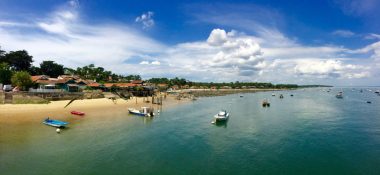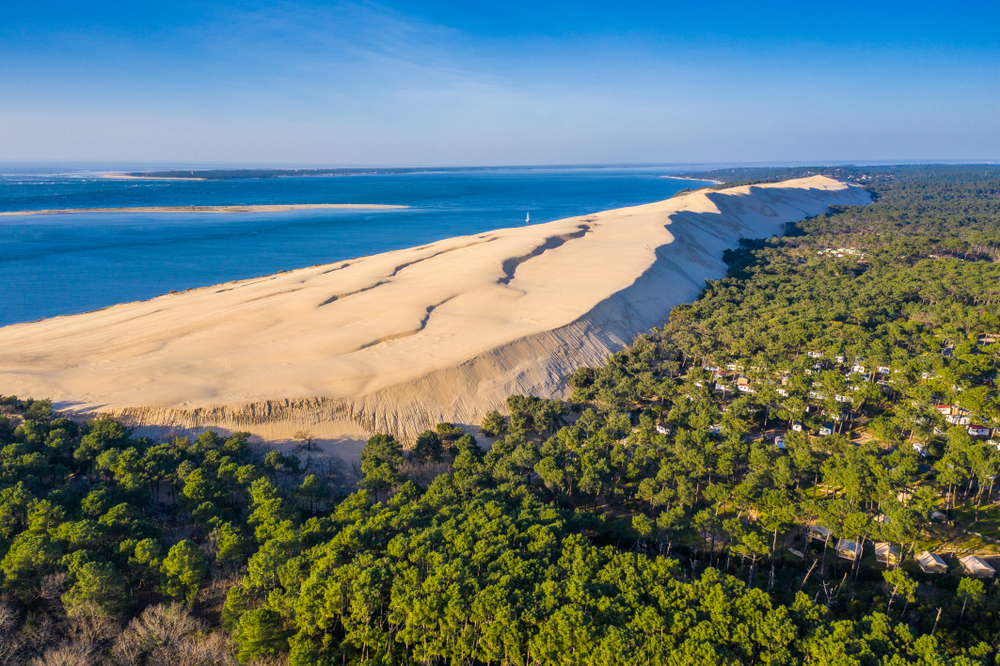About 60 kilometers southwest of Bordeaux, on the beautiful French Atlantic coast, lies the seaside resort of Arcachon. Once a small fishing village, Arcachon is now a popular tourist destination, especially because of its beautiful sandy beaches, scenic features and picturesque architecture.
The landscape
The special tides at the Bassin d’Arcachon (Arcachon Basin) have created the highest dune in Europe. The Dune du Pilat is 110 meters high, 2.7 kilometers long and 500 meters wide. Out in the sea, at the mouth of the bay, there is an extensive sandbank, the Banc d’Arguin. The sandbank, which is two kilometres wide and four kilometres long at low tide, is a nature reserve and is an important breeding area for many bird species, such as the sandwich tern or the oystercatcher. On sheltered paths and accessible by boat, the Banc d’Arguin can be visited. The bird island, the Ile aux Oiseaux, is also a small bird paradise. Located in the heart of the Arcachon Basin, the quiet little island is home to its many wooden huts protected from the water by stilts. The traditional stilt huts are called “Cabanes Tchanquées” here and are a popular destination for photographers.
Culinary specialties and markets
There are several oyster farms in the Bassin d’Arcachon. Guided tours are also offered – you can accompany the oystercatchers on their boats and learn a lot of interesting facts about the mussels, their habitat and the breeding conditions. Many regional fishermen are also accompanied and invite you to exciting fishing trips. There are regular markets in the city. These offer regionally grown fruit and vegetables, shellfish and, of course, freshly caught fish and oysters harvested here. The most famous and must-see markets in the area are the Halles du Cœur de Ville, the local market of Moulleau, the market on the Place de l’Aiguillo and the night market of Arcachon. The latter offers in particular handicrafts, jewellery, clothing or books.
Château Deganne and the Moorish Park
The leap from an insignificant fishing village to a popular tourist resort was made in 1853. This is where the Château Deganne was built, the city casino. From this point on, many holidaymakers and soldiers of fortune were lured to the city and massive growth took place. The Château Deganne fell victim to a fire in 1977, so it no longer stands today. Nowadays, the Moorish Park, which was created around the casino, has become a popular destination for walkers. There are ponds and fountains, playgrounds for children and some trees that are over a hundred years old.
The Winter City
In the so-called “Winter City”, time seems to have stood still. In this higher district there are historic villas, through whose partly eccentric architecture the builders of the time expressed themselves. It is possible to book guided tours of the winter city and learn a lot about the former inhabitants of this district through a guided tour. The white pavilion on Place Fleming, formerly known as Place des Palmiers, is a special highlight. High-ranking nobility celebrated here and met for organized hunts. The whole winter city can also be observed from above: there is a lookout tower, the “Sainte-Cécile”. An architect who later became very famous was involved in the construction of the tower: Gustave Eiffel.
Cap-Ferret

The small peninsula of Cap Ferret offers a view of the bay from everywhere. A special view can be obtained by climbing the 258 steps of the 53-metre-high lighthouse. From above, you can see the oyster farms, the bird island, the Dune du Pilat and of course the sea as far as the eye can see. On Cap Ferret, there are brightly painted fishermen’s huts everywhere, which stand close together and can be explored via narrow streets.
The Basilica of Notre-Dame
Arcachon has an impressive Gothic church, the Basilica of Notre-Dame. As the name suggests, the building was dedicated to the Blessed Virgin Mary, and there is also a little story behind it. Here, a Franciscan monk left his monastery in Bordeaux and reached the Dune du Pilat on his journey south. From there, he observed two ships threatening to break on the coast. The monk prayed and then experienced how the sea calmed down and the ships could continue safely again. He found a small statue of the Virgin Mary with the baby Jesus on the beach and decided to build a chapel in her honor. At that time, it was initially made of wood, until the basilica was built on its site in the middle of the 19th century


